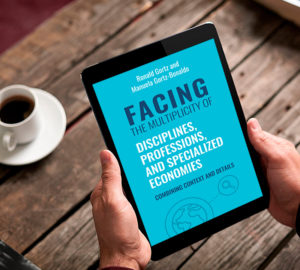Facing the multiplicity of disciplines, professions, and specialized economies:
Combining context and details
Ronald Gortz
Manuela Gortz-Bonaldo
Format: ebook
Where can I buy it?
About the Book:
We live in a world with an accelerated pace in the multiplication of its activities. We see specialized disciplines, professions, economies, technologies, digital platforms, and ecosystems emerging all the time. This movement certainly has repercussions on essential decisions of people, organizations, recruitment of professionals, selection of product and service providers, education at all levels, legislation, and new solutions development.
How to deal with these changes?
How can each person and organizations locate themselves in the face of so many possibilities in an increasingly digitalized world that grows in its diversified activities?
Isn’t it the case that the more contextual vision added to the detailed perspectives is a growing need for all areas and for generalists and specialists, or leaders and techno-operational professionals, to align their purposes?
With this book, we share information and insights so that readers can better understand the changes we are experiencing and what implications these changes signal for the future, and so that people can better position themselves in the society of which they are a part.
Table of Contents
Preface
Reasons to write and read this book
1. A separate approach of historical facts, consequences and challenges, and pointing out solution paths
- Causes, diagnosis, and search for solutions
- Divergent knowledge X convergent knowledge
- General demands for a global set of actors X specific demands for each actor
SECTION 1 – HISTORICAL FACTS
2. Society’s relationship with technology
3. Dynamics that motivated the specialization of human activities in society
- Specialization of human activities from a linear perspective
- Specialization of human activities from the perspective of causative factors
- Specialization of human activities from the perspective of large historical groups of economic activities
- Specialization of human activities from the perspective of cyclical, parallel, or simultaneous movements
- Specialization of human activities from the perspective of valuing their purposes in specific economies
SECTION 2 – CONSEQUENCES AND CHALLENGES
4. General consequences
- Multiplier (and not suppressive) movements of economic activities
- More possibilities for inclusion, but also for mismatch
- More possibilities to facilitate processes, but also to overload them
- Need for attention to the transformations caused by new activities
- Arrangements and disarrangements of the processes of specialization and multiplication of economic activities
- Changes in the locations of economic activities and reallocation of opportunities
5. A central demand of the process of economic activities multiplication
- The combination of context and details perspectives
6. Consequences and challenges from different perspectives
- Linear perspective
- Perspective of causative factors and solution-demand networks
- Perspective of the large historical groups of economic activities
- Perspective of cyclical, parallel, or simultaneous movements of changes
- Perspective of specific economies
7. Consequences and challenges for multiple actors in society
8. Consequences and challenges for some segmentation of society’s activities
- Education
- Legislative, regulatory, supervisory, and judiciary spheres
- Healthcare
- Systems development
SECTION 3 – SOLUTIONS PATHS
9. Solutions in a context of multiplication of alternatives and knowledge
10. New global mappings for the plurality of economic activities
11. Recategorization of economic activities and their relationship with technology
12. Facing the multiplicity of theories, disciplines, professions, and specialized economies for a new categorization of activities
13. Facing the multiplicity of theories, disciplines, professions, and specialized economies for each actor to identify one’s area (or areas) of action in society
14. The exercise of combining multiple theories, disciplines, professions, and economies according to the activity aimed by each actor
15. Solution paths from different perspectives
- Solution paths from the linear perspective
- Solution paths from the perspective of causative factors
- Solution paths from the perspective of the large historical groups of economic activities
- Solutions from the perspective of cyclical movements
- Solutions from the perspective of specific economies or economic activities aimed at valuing some notable purposes of society
16. Solution paths for the multiple actors in society
17. Solution paths starting from some segmentations of society activities
- Education
- Legislative, regulatory, supervisory, and judicial parties
- Healthcare
- Development of digital systems or solutions
Conclusion
Acknowledgments
About the Authors
References
Other Books in the Series:






